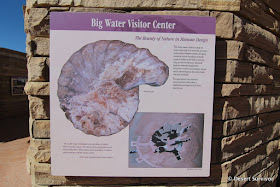We started our last day of Fall Break with sunrise at Horseshoe Bend. After a few errands in Page, we headed across the Grand Canyon and stopped at the Carl Hayden Visitor Center at Glen Canyon Dam National Recreation Area and Lake Powell.
They have some cool dinosaur tracks outside the visitor center.
The views were spectacular, and when we found they had room on the 9 am dam tour with no age restrictions, I jumped at the chance. I had been on the tour about fifteen years ago and still remembered the eerie feeling of being inside a dam that is holding back so much water (26.2 million acre-feet at full capacity).
We went through security and then took an elevator down into the cliff below the cool looking visitor center.
We walked through a tunnel out onto the dam.
The concrete for the dam was poured nonstop, every five minutes around the clock, from June 1960 to September 1963. The source of rock and sand was nearby Wahweap Creek. The cross section of polished concrete that Desert Girl is admiring shows how big some of the aggregate was.
We could look over the edge of the dam to see how curved it is. It's considered a concrete-arch dam, the second tallest in the United States.
Eight turbines can generate electricity. A retired one is on display and looks enormous.
Our guide did a nice job explaining the history of the dam. Lake Powell started filling in March 1963 and took 17 years to reach full water, in 1980. The lowest the water has been since then is about 146 feet below maximum elevation. Right now, the lake is about 93 feet below maximum elevation. The penstocks (openings for water to go to the turbines) are about 200 feet below maximum elevation.
We walked part way across the dam and took a photo of the Glen Canyon Bridge in the background.
We could also see the hydroelectric plant far below us. And some green stuff. What is it? We would soon have a closer look.
It was time to go into the dam. Our guide had us look up the elevator shaft as we got off. It was cool. And a long way up, over 500 feet if I remember right.
We walked through more tunnels and then onto a bridge connecting the dam to the hydroelectric plant. We saw that the green was Bermuda grass, which is primarily used to keep dust down. The hatches lead to the eight tunnels that allow water to reach the turbines.
Inside the hydroelectric plant, we had a glimpse of the generators. Four were on-line, which is normal for this amount of water.
Then it was time to retrace our steps. The tour used to be longer (I remember some dank and dark corridors), but due to security reasons, it's been shortened.
Below you can see the turbine on the left side of the dam, and the elevator structure in the middle. I like the shadow of the bridge on the dam!
We really enjoyed the tour. We still had a six-hour drive, but I wanted to take the time to walk out on the bridge. We had some more great views from there.
On the downstream side of the dam we could see the cold Colorado River from deep in the lake being released. We also saw little boats that a tour company uses. They drive through a two-mile long access tunnel to get to the river's level.
The bridge is well-fenced, so safe for kids.
Finally it was time to load up. We made two quick interesting stops on the way home, including the Grand-Staircase Escalante Big Water Visitor Center, which focuses on paleontology. Since Desert Girl wants to be a palentologist when she grows up (at least for now), she was fascinated.
We also did a short hike to the toadstools, which I enjoyed a lot more than the kids.
They just wanted to dig for dinosaur bones!
Overall it was a great fall break, and we enjoyed exploring some new areas.





















I always remember this place as in Transformer 1 Movie. Power Supply Company
ReplyDelete